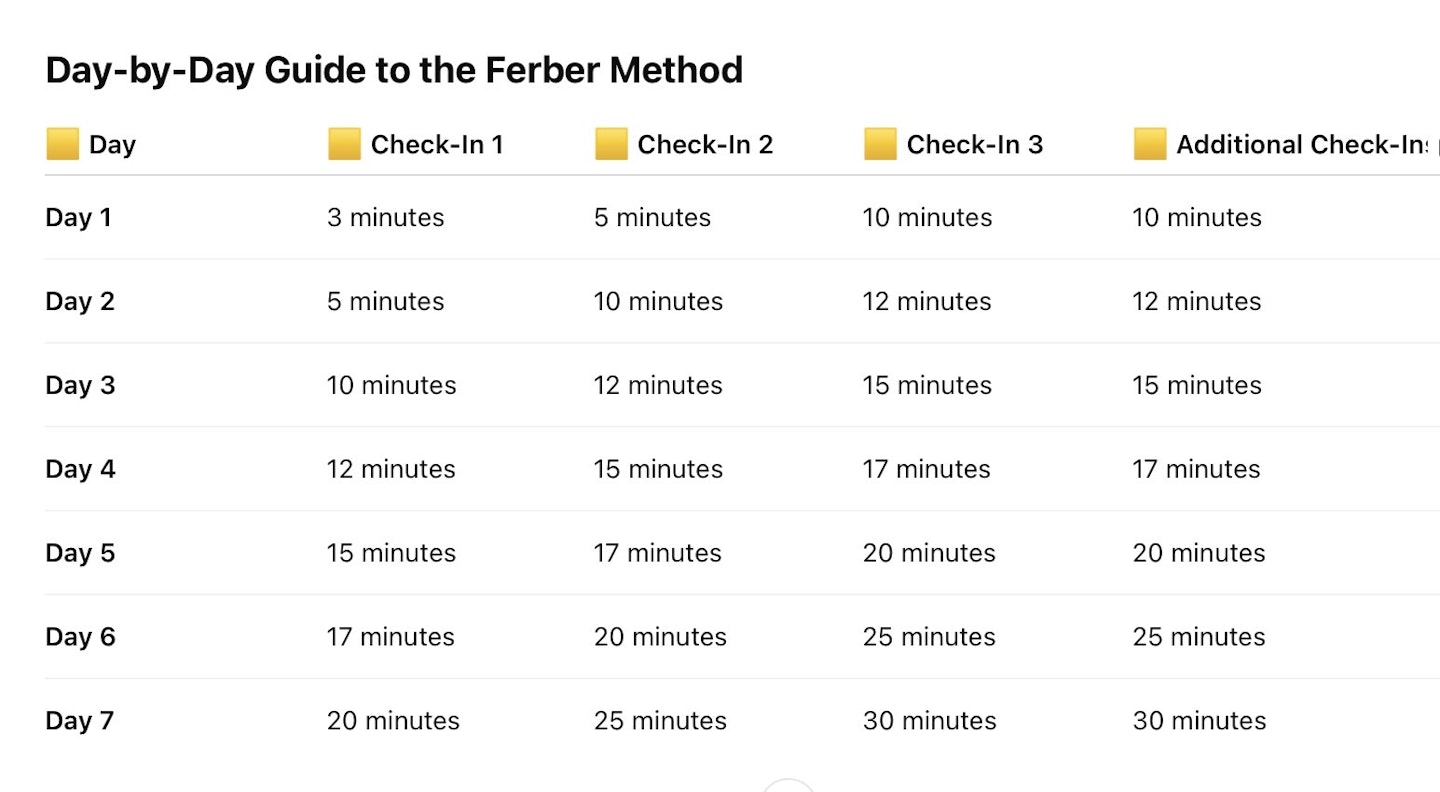
Medically Reviewed by: Dr. Deborah Lee
There are many different methods of sleep training to help get your baby into a good bedtime routine, one of which is the Ferber method. Here, we look at what it is and how it could help your baby (and you) get some much-needed shut-eye.
What is the Ferber method?
According to Dr. Deborah Lee, they say: "The Ferber method is a sleep training technique for babies, which was invented in 1985 by a paediatrician called Dr Richard Ferber. The idea is to help a baby learn how to go off to sleep by themselves instead of having to be rocked to sleep by a parent, says Dr. Lee.
How does the Ferber method work?
The Ferber method is a controlled crying technique. It’s not the same as the 'cry-it-out’ method, as the parent goes into the room to soothe the baby at timed intervals. It is only suitable for a baby from around 6 months of age, and it should be started before they can sit up, crawl, stand or walk.
The psychology behind this technique is that a baby needs to be able to go off to sleep independently of his/her parents. They should not learn that sleep only happens in the presence of a parent. They need to be able to drift off to sleep alone, says Dr. Lee.
For a mother, it may seem cruel as no mother likes hearing her baby cry or seem distressed, without being able to pick them up. Some think that the Ferber method is ‘tough love.’ But tough as it may be, it is teaching a baby this very important skill for life.
Sleep specialists believe that using a sleep training technique such as the Ferber method leads to less stressful bedtimes and less likelihood of night-time awakenings. Babies who have undergone sleep training tend to sleep for longer and have better quality sleep. It also has significant benefits in reducing parental stress, anxiety and depression, says Dr. Lee.
How do you do the Ferber method?
The key is to establish a good bedtime routine from an early age, with an early evening feed, a nappy change, a cuddle and a story. Keep the room dark/dimly lit, quiet and cool. Once you know all your baby's needs have been met, you put them down in the cot, drowsy but awake. Then leave the room.
If your baby cries, wait 2 minutes, then go back in and soothe them with a pat on the back and some gentle words. It's best not to pick them up. After a few moments, leave the room, says Dr. Lee.
This time, wait 3 minutes before you go back in and do the same thing.
If they continue to cry, repeat the exercise, but this time wait 5 minutes.
The idea is to be firm but consistent, and wait a little longer in between each time you go back into the room.
If it doesn’t work and you’ve been trying for an hour, stop for an hour, then try again from the start, says Dr. Lee.
Eventually, they will fall asleep by themselves. The typical time for the baby to fall asleep is 40 – 60 minutes. Most parents report success within 3-4 nights of trying this. If there has been no progress after 7 nights, it’s best to stop and think of a different method.
Note that you can sit in the corner of their bedroom if you wish, but if they can see you, this can be confusing for the baby, as they don’t understand why you are there but not picking them up.
Also, if you go in to soothe them, end up picking them up and rocking them, and they fall asleep on your shoulder, this is counterproductive. The objective is to help them get sleep by themselves in their own cot.
Ferberisation should never be attempted if a baby is showing any signs of illness, for example, if they have a fever, says Dr. Lee.
When to start ‘Ferberizing’ your baby?
You can start the Ferber Method when your baby is 6 months old. The NHS does not recommend this method for babies under 6 months of age. Young babies, less than 3-4 months old, need frequent feeding through the night. They also recommend that a baby under 6 months sleeps in the same room as the parent, so obviously this would not work. Ideally, Ferberisation should be started before they can sit unaided, crawl, stand or walk. The method can be used on babies aged 1 year and older, says Dr. Lee.
The method is not suitable for a baby with -
-
Some chronic diseases
-
Any medical condition that causes pain
-
Loud snoring (as this signifies a blocked airway)
-
Developmental disorders such as Down’s Syndrome or autism
-
A child with depression or anxiety
-
Frequent bad dreams
-
A particularly stressful or difficult home environment, says Dr. Lee.
What is the effect of the Ferber method on babies?
In the beginning, a baby will usually cry when put down to sleep. But as time passes, they will cry for shorter periods as they learn to go to sleep by themself. They will also become more used to going back to sleep by themselves when they wake in the night, says Dr. Lee.
Are there any tips for Ferber sleep training success?
Have a good routine both in the daytime and at night. Keep your baby active during the day and monitor their daytime sleep. Try not to let them nap too close to bedtime.
Have a good bedtime routine from an early age. After the early evening feed – probably around 6 pm – keep your voice soft and calm, and discourage active play. Feed them, bathe them, brush their teeth (if they have some!), change their nappy, have some cuddle time and look at some books, then put them down for the night. This regular routine is the cue for the baby’s brain that it’s time to go to sleep for the night. When you put them in the cot, they should be drowsy but still awake, says Dr. Lee.
Keep their bedroom cool, dark and quiet.
-
The ideal room temperature for a baby’s bedroom is 16 °C- 20 °C. Don’t overdress your baby. They only need a well-fitted cot sheet, no pillow or duvet. They need a light-weight sleep suit and in the winter, perhaps a baby sleeping bag (instead of a blanket) with an appropriate tog rating.
-
Keep the lights dimmed, or use a baby night light, and leave the door ajar. You can keep an eye on your baby using a baby video cam.
-
Avoid loud noises, however, softer background noises like the vacuum cleaner or the washing machine are a form of white noise, which has been shown to help a baby sleep as it is reminiscent of being in the womb. Some parents like to use a white noise machine, says Dr. Lee.
The key to success is to be calm, firm and consistent. Stick to the plan and time the visits into the bedroom with a timer. This is essential as 30 seconds of crying will feel like 10 minutes! Try not to pick your baby up, just pat them on the shoulder and speak gently to them. If you have to cave in, leave it for a few nights, then try again. Make sure all other babysitters/carers know you are doing this and that you all stick to the same method. Be patient – it takes time, says Dr. Lee.
Don’t change anything else about your baby’s care/routine while you are doing the sleep training. Just focus on the sleep training.
You might like to keep a baby sleep diary so you can monitor their progress, says Dr. Lee.
Ferber method chart: step-by-step
This Ferber method chart was first published in Dr Richard's book, Solve Your Child's Sleep Problems. It details the recommended check-in times and how to make these intervals longer gradually as you progress through the sleep training routine.

What's the difference between the Ferber method and the CIO method?
The Extinction method (also referred to as the cry it out method, or CIO method), which is a more extreme version of the Ferber method.
The key difference between the extinction method and the Ferber method is that during the Ferber sleep training method, you periodically go and check on your child at specific times.
The extinction method entails you taking your child to bed, saying goodnight and leaving them there to cry it out until they go to sleep. It is considered a controversial method, however, there are those who find great success from it.
Pros of the Ferber method
• It works fast - you could see improvements within a week.
• Your baby learns to sleep through the night.
• It helps your baby deal with separation better, for example, if they are to stay at a relative's house for the night or with a babysitter.
• It's less extreme than the CIO method.
Cons of the Ferber technique
• It's emotionally tough to do as a parent - hearing your baby crying, instinctively you want to go to them and hold them.
• Some research suggests crying for long periods could cause emotional distress to the child, although other studies disagree.
Meet the expert
Having worked for many years in the NHS, mostly as Lead Clinician within an integrated Community Sexual Health Service, Dr Deborah Lee now works as a health and medical writer, with an emphasis on women's health, including medical content for Dr Fox pharmacy. She has published several books and remains passionate about all aspects of medicine and sexual health. After completing her Medical Degree at the University of Southampton Medical School in 1986, Dr Lee trained as a GP and after a number of years specialised in Sexual & Reproductive Health (S&RH).
Meet the author
Bryony Firth-Bernard graduated from the University of Gloucestershire with a first in Journalism and went on to work as a reporter at Heart Radio West before becoming the lifestyle intern across Good Housekeeping, Prima and Red magazine.
Adejumoke Ilori is a Commercial Content Writer for Mother&Baby. A proud mum to a little girl, Adejumoke has built a career across various leading digital platforms, creating content that empowers women from all walks of life. She is passionate about sharing real-life stories, particularly those that focus on relationships, self-love, and the journey of motherhood, offering readers a relatable and authentic perspective.
